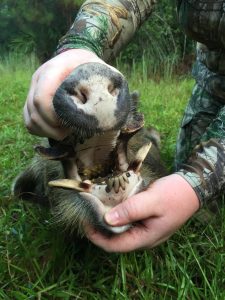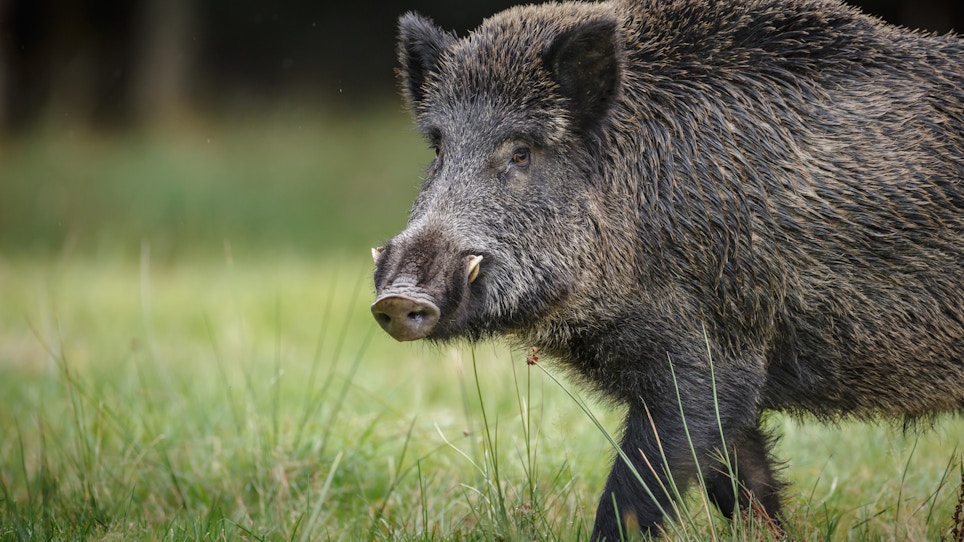Bowhunters across the country contact us here at Bowhunting World every day asking all sorts of questions. One of the most frequent is, “What can I go hunt that won’t empty my bank account, is fun, has a good chance for success, and will help me fill my freezer?”
That’s a more complicated question than it at first seems. To simplify it, I simply answer, “Wild hogs.”
A Brief History on Hogs and Hog Hunting
In the past three decades, wild hogs have been spreading across America like ants at a picnic. Today, estimates — guesstimates, really — place the current number in the U.S at about 5 million piggies spread across 45 states. Populations now exist as far north as Michigan, North Dakota, and Oregon; this range expansion is mostly a result of illegal translocation of pigs by humans.

This big spotted boar was taken down by Bowhunting World’s associate editor Anna Claire Howard.
As I wrote in my 1980s book, Hunting Wild Boar in California, true wild hogs of the family Suidae are not native to the New World. The only fossils discovered to date of Sus scrofa have come only from the Palearctic, Oriental, and Ethiopian regions of the world. Most scientists believe the wild boar first appeared in Eurasia and northern Africa, and that these wild hogs were the progenitor of all the various modern-day wild and domestic swine. Wild boar are an immigrant to North America whose ancestors came from the Old World.
In fact, the only pig-like animal native to the New World are the peccaries, which include the collared peccary, or javelina; peccaries can be found from the southwestern portion of the United States southward to the Patagonia region of Argentina. However, it is possible that both the wild boar and peccary shared as a common ancestor the gigantic wild hog that roamed the earth during the lower Miocene period, some 25 million years ago.
The first introduction to what is now the continental United States is generally believed to have occurred in 1539, when Governor Hernando de Soto established a camp in Charlotte Harbor, Florida. de Soto brought the swine with him both to feed his men and to leave behind as a way to provision new settlements established along his line of march. As he continued on, de Soto’s herd of swine grew, soon becoming so large they were hard to control. In fact, as the party continued on — eventually covering some 3,100 miles and reaching parts of what are now eight additional states in the southeastern U.S. in three years — the herd of hogs grew to some 700, with many additional hogs escaping to live on their own or being stolen by local inhabitants. Many years later, Eurasian wild boar were introduced into parts of the United States for hunting purposes, first in New Hampshire in 1886, then at Hooper’s Bald, North Carolina, in 1911, then near Monterrey, California, in 1925. In areas where domestic pigs and Eurasian wild boar were found together in the wild, interbreeding occurred. Today, many hybrid populations exist throughout the wild pig’s range. For a map of hog distribution across America, go to http://bit.ly/2dftfcT.
Why You Should Be Hunting Wild Hogs
1. They're An Expensive Menace
Between their prolific year-round breeding and habitat destruction, wild hogs are driving game managers and landowners crazy. Between the damage they cause and efforts to control them, experts estimate it costs some $1.5 billion annually to try and control them. The federal government has allocated some $20 million toward thinning their ranks. The USDA program involves destroying the wild pig population in two states every few years, starting with the states that have the fewest pigs. Among techniques for doing so are trapping, shooting pigs from helicopters and sending a radio-collared “Judas pig” to reveal the whereabouts of his group..
2. It's A Growing Industry
All this has spawned a growing industry revolving around wild hogs. In most places, the season never closes and bag limits are quite generous. There are some hog hunting opportunities on public land, but most populations are concentrated near agriculture, which means private land. A robust outfitting business has arisen around hunting feral hogs. In most cases, the cost to hunt hogs is much less than hunting deer or other big game species. And landowners with a hog problem are often more likely to permit bowhunters access than when they seek to hunt deer, turkeys, or other species.
3. It Will Make You A Better Bowhunter
Hunting wild hogs is great fun and also great practice when preparing to hunt other species. With their tremendous sense of smell and excellent hearing, stalking hogs on foot is super practice when tuning up for western spot and stalk hunts, for example. They’re also tough as old boot leather, requiring precise shot placement. And the meat is to die for
As someone who helped pioneer the hunting of wild hogs on the West coast back in the late 1970s and early 1980s, these highly-intelligent critters hold a special place in my heart. Today, most bowhunters don’t have to travel to the moon and back to find decent hog hunting.
How many of you have a hog hunting adventure you’d like to share? I’d love to hear about it! Email me at brobb@grandviewmedia.com, send a photo if you can, and tell me all about it.
You Killed It, Now Eat It: Wild Boar Chile Colorado
According to Hank Shaw's website, "Hunter, Angler, Gardener, Cook," Chile Colorado is essentially a red chile sauce seasoned with cinnamon and Mexican oregano, thinned with a little broth and traditionally served over beef (which Shaw swaps out for wild boar). According to Shaw, there are many variations on this sauce and a variety of meat can be used — everything from turkey legs to pheasant to venison — but he recommends his way with freshly harvested wild pork.







